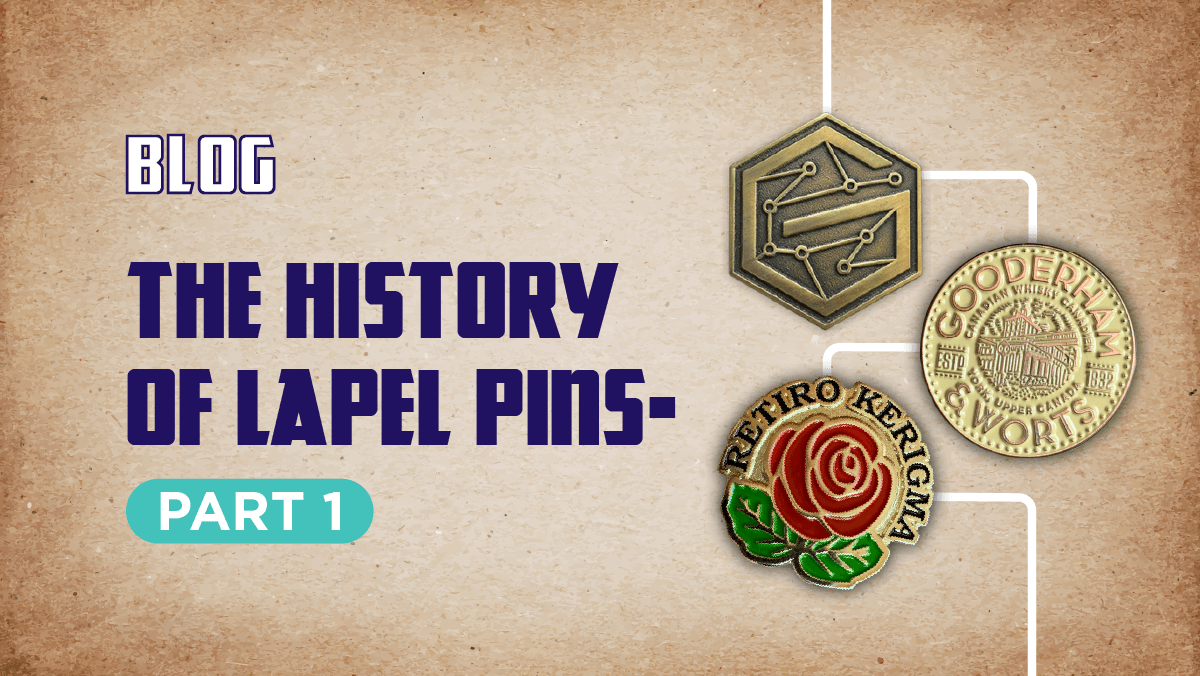Part One – The History of Lapel Pins

[et_pb_section fb_built=”1″ _builder_version=”4.7.5″ _module_preset=”default” width=”70%” width_tablet=”100%” width_phone=”100%” width_last_edited=”on|phone” module_alignment=”center”][et_pb_row _builder_version=”4.9.4″ _module_preset=”default” module_alignment=”center” custom_padding=”0px||||false|false”][et_pb_column type=”4_4″ _builder_version=”4.7.5″ _module_preset=”default”][et_pb_post_title comments=”off” featured_image=”off” _builder_version=”4.9.7″ _module_preset=”default” text_orientation=”center”][/et_pb_post_title][/et_pb_column][/et_pb_row][et_pb_row make_equal=”on” _builder_version=”4.7.5″ _module_preset=”default”][et_pb_column type=”4_4″ module_class=”ds-vertical-align” _builder_version=”4.7.5″ _module_preset=”default”][et_pb_image src=”https://galaxydesignsquad.com/wp-content/uploads/2022/04/gds_april12_fbli_1.png” alt=”Part One – The History of Lapel Pins” title_text=”part-one-the-history-of-lapel-pins” align=”center” admin_label=”Image” _builder_version=”4.9.7″ _module_preset=”default”][/et_pb_image][/et_pb_column][/et_pb_row][et_pb_row _builder_version=”4.7.5″ _module_preset=”default” locked=”off”][et_pb_column type=”4_4″ _builder_version=”4.7.5″ _module_preset=”default”][et_pb_text admin_label=”Part One – The History of Lapel Pins” _builder_version=”4.9.7″ _module_preset=”default”]
Collectible enamel lapel pins are seen almost everywhere, but these unique art forms were not originally created as jewelry or accessories. In fact, the first-ever recorded pins were made of thorns or flint and used to secure pieces of clothing like loincloths. Their designs have evolved and their use has influenced many cultures over several millennia. As with most creative endeavors, learning more about its history can help spark new ideas; learning about the history of early painters may inspire you to pick up a brush while studying the history of ceramics, you may feel the urge to buy a potting wheel – so, of course, learning about the history of lapel pins can help inspire new and creative pin ideas! Let’s look at some of the first-known lapel pins in history and how they’ve helped shape the wearable art we know and love today.
Beginnings and the Bronze Age
Pins were initially crafted for functionality as a way to fasten items of clothing or cloaks. They were first made out of metal in the Bronze Age, which started in 3300 BCE. Celts and Vikings also used pins as fasteners during the Early Medieval period; these were made with a diverse level of detail and were worn by both men and women.
Egyptians and Enameling
While it’s commonly recognized that ancient Egyptians didn’t invent lapel pins, they are known to have developed the process of inlaying and enameling around 1800 BCE. Grecian artists refined this craft 600 years later, using powdered glass to fill spaces between the wires of filigree designs. The decorative pieces produced from the firing process were eye-catching and revolutionary. They likely influenced the Chinese, who were the first to have developed enamel pins between 1271 and 1368 during the Yuan Dynasty. Their work evolved into the enamel process for custom enamel lapel pins today.
Byzantine and Beyond
Brooches and pins became more ornamental during the Byzantine era between 330 and 1450 CE, but they were still commonly used to secure a scarf or shawl. Around the 16th century, mourning brooches were created to commemorate loved ones who had passed and continued to evolve in detail and design through the 18th and 19th centuries, eventually including compartments for mementos like bits of hair.
Revolutionary Recognition
Some of the first appearances of enamel and lapel pins were back during the Revolutionary war of 1775 and into the Civil War of 1861, when soldiers used them to identify different units. Later, people would use pins to support politicians during events and rallies and during the first World War, they were used as symbols of merit and service, often embellished with a ribbon or dangling ornament.
Sophisticated Souvenirs
During the later years of the 19th century, many upper-class families in Europe embarked on a tour of cities like Venice, Rome, and Florence to exhibit their “cultural sophistication.” While traveling, they collected small pins as jewelry souvenirs of their adventures; often, these were detailed with depictions of Roman architecture and scenes of animals, flowers, and birds.
Marching Orders and Mementos
During the first and second World Wars, the popularity of “military jewelry” grew out of a desire for family members and spouses of soldiers to wear a small token of support for their loved ones that were off in battle, known as “sweetheart brooches.” Because they came in a variety of designs, from basic and affordable to ornate and diamond-studded replicas of regimental badges, they were very popular and mass produced to meet demand.
Lapel Pins Today
The colorful history of lapel pins has culminated into a popular and expanding industry, with new designs emerging every day. Do you create and adore the history of art through the ages? If so, what historical era inspires you most? If your artistic visions are inspired by history, we can help you bring them to the present by creating custom lapel pins inspired by the past! Contact us today!
[/et_pb_text][/et_pb_column][/et_pb_row][/et_pb_section]
Related articles







